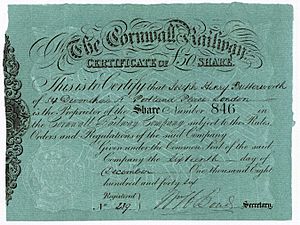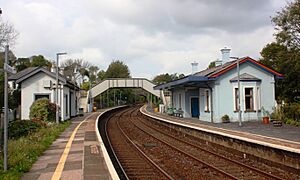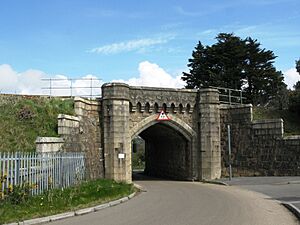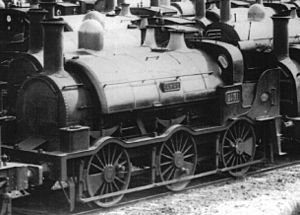Cornwall Railway facts for kids
Quick facts for kids Cornwall Railway |
|
|---|---|
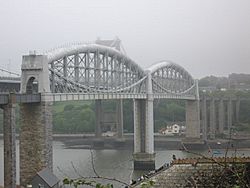
The Royal Albert Bridge
that carries the route of the Cornwall Railway across the River Tamar |
|
| History | |
| 1835 | Proposal for a railway from London to Falmouth |
| 1839 | Proposal for the Cornwall Railway |
| 1846 | Cornwall Railway Act |
| 1848–52 | Construction suspended |
| 1859 | Opened from Plymouth to Truro |
| 1863 | Opened Truro to Falmouth |
| 1867 | Branch opened to Keyham Dockyard |
| 1876 | Cornwall Loop line opened in Plymouth |
| 1889 | Line sold to the Great Western Railway |
| Engineering | |
| Engineer | Isambard Kingdom Brunel |
| Gauge | 7 ft 1⁄4 in (2,140 mm) converted to 4 ft 8 1⁄2 in (1,435 mm) standard gauge in 1892 |
| Successor organisation | |
| 1889 | Great Western Railway |
| 1948 | British Railways |
| Key locations | |
| Headquarters | Truro, Cornwall |
| Workshops | Lostwithiel |
| Major stations | St Austell Truro Falmouth |
| Key structures | Royal Albert Bridge and numerous timber trestle viaducts |
| Route mileage | |
| 1859 | 53.50 miles (86.10 km) |
| 1863 | 65.34 miles (105.15 km) |
The Cornwall Railway was a special railway line in England. It ran from Plymouth in Devon to Falmouth in Cornwall. This railway was built in the mid-1800s. It used a wider track than most railways, called a broad gauge.
Building the railway was very hard. The company often ran out of money. Because of this, they had to sell their line to a bigger company, the Great Western Railway.
The Cornwall Railway is famous for the amazing Royal Albert Bridge. This bridge crosses the River Tamar. The railway also had many viaducts (long bridges) made of wood. These were cheaper to build but cost a lot to fix. Eventually, they were rebuilt with stronger materials like stone.
This railway became the main route to many holiday spots in Cornwall. In the early 1900s, it carried tourists in summer. It also transported vegetables, fish, and flowers from Cornwall to markets in London. Today, most of the original route is still used. It is part of the Cornish Main Line.
Contents
Building the Cornwall Railway
The idea for the Cornwall Railway started because people in Falmouth were worried. Falmouth was an important port. But another port, Southampton, was becoming more popular. Southampton had a new railway that could get mail to London faster. Falmouth needed its own railway to keep up.
Choosing the Best Route
At first, people wanted a direct railway line to London. This would have been a huge project. But the government moved most of the mail ship business to Southampton. This meant the railway would lose a lot of money. So, a shorter plan to connect to Plymouth became the main goal.
Crossing the River Tamar near Plymouth was a big challenge. Isambard Kingdom Brunel, a famous engineer, was asked to solve this. He designed the incredible Royal Albert Bridge at Saltash. When it was built, it was one of the most amazing engineering projects in the world.
The land in Cornwall was very hilly. There were many valleys to cross. Because money was tight, Brunel designed wooden viaducts. These were cheaper but needed a lot of repairs. Over time, these wooden bridges were replaced with stronger stone or brick ones.
The railway also started with only one track. This saved money but made it harder for many trains to run at once. Later, some sections were made into double tracks.
Early Ideas and Challenges
Before Brunel, another engineer named Captain William Moorsom designed a route. His plan included using a steam ferry to cross the Hamoaze (part of the River Tamar). Trains would have to be split up and loaded onto the ferry. This idea was not practical and was rejected.
Moorsom also planned to use an "atmospheric system" for trains. This system used a tube between the rails. A wagon with a piston inside the tube would pull the train. Stationary engines would suck air out of the tube to create movement. This meant no heavy steam locomotives were needed. It seemed like a good idea for steep hills. However, this system had many problems and was never used on the Cornwall Railway.
Starting Construction
In 1846, the plan for the Cornwall Railway was finally approved. Brunel's design for the Royal Albert Bridge was accepted. However, a financial crisis called the "railway mania" hit. Many people had invested too much money in railways and lost it. This made it very hard to get money for the Cornwall Railway.
Work on the line was very slow. In 1851, Brunel suggested building only a single track to save money. This helped, and construction began on parts of the line. In 1853, a contract was signed to build the Royal Albert Bridge.
The company still struggled for money. In 1855, bigger railway companies like the Great Western Railway agreed to help. They guaranteed the Cornwall Railway's loans. This made it easier to finish building.
Construction of the Royal Albert Bridge began in 1854. It was a huge job, taking five years to complete. The bridge is about 730 yards long. It has two main spans, each 455 feet long. The total cost was about £225,000.
Opening and Growth
The railway from Plymouth to Truro was finally ready. On May 2, 1859, Prince Albert officially opened the Royal Albert Bridge. The bridge was named after him. Passenger trains started running on May 4, 1859. Goods trains began on October 4, 1859.
At first, there were not many trains. The company had little money for rolling stock (train cars). But soon, the railway started carrying lots of fish, potatoes, and broccoli from West Cornwall.
Reaching Falmouth and Changes
The original goal was to reach Falmouth. But money problems delayed this. In 1861, the Cornwall Railway agreed to lease its line to the bigger Associated Companies (including the Great Western Railway) for 1,000 years. This gave them the money to finish the line to Falmouth. This section opened on August 24, 1863.
The West Cornwall Railway, which connected to Penzance, used a different track width (standard gauge). This meant goods had to be moved from one train to another at Truro. To make things easier, the Associated Companies took over the West Cornwall Railway. They installed broad gauge rails there too. This allowed trains to run directly from Penzance to London. The Falmouth line then became a branch line.
In 1876, the Associated Companies joined together to form the Great Western Railway. This meant the Great Western Railway now managed the Cornwall line.
The Railway in the 1900s
The wooden viaducts were very expensive to maintain. They cost about £10,000 each year. So, the Great Western Railway started replacing them with stronger stone or iron structures. This work continued until 1904 for the main line. The viaducts on the Falmouth branch were replaced by 1927.
In 1892, a big change happened. All the broad gauge tracks in the area, including the Cornwall Railway, were converted to standard gauge. This was a huge task done over one weekend. On Monday, May 23, 1892, trains ran on the new standard gauge tracks.
The Great Western Railway also worked to double the track on the main line. By 1904, most of the line from Plymouth to Truro had two tracks. Only the Royal Albert Bridge remained single track. A new section of line was built near St Germans in 1908 to avoid a difficult single-track part.
The Great Western Railway promoted Cornwall as "the Cornish Riviera." They ran fast trains for holidaymakers and for goods like minerals. Even though the line had sharp curves and steep hills, it became very busy, especially in summer.
Today, the original Cornwall Railway route is still a key part of the rail network in Cornwall.
Surviving Structures
Many parts of the original Cornwall Railway still exist today.
- The Royal Albert Bridge is still in full use.
- Many stone piers from Brunel's original wooden viaducts can still be seen.
- Smaller stone bridges and stations like Liskeard and St Germans are still used.
- The stations at Par and Saltash were also built by the Cornwall Railway.
- At Perranwell on the Falmouth branch, an original goods shed remains.
Railway Branches
The Cornwall Railway itself did not build many branch lines. Only a short branch to Keyham was opened in 1867 to serve the naval dockyards.
However, other independent railways connected to the Cornwall Railway:
- The West Cornwall Railway connected to Penzance in 1859.
- The Lostwithiel and Fowey Railway connected in 1869.
- The Newquay and Cornwall Junction Railway connected in 1869.
In 1876, the Cornwall Loop was opened in Plymouth. This allowed trains to avoid reversing at the main station. It is now part of the main line.
Stations of the Cornwall Railway
- At Plymouth, Cornwall Railway trains used the Millbay station (closed in 1941).
- Devonport
- Saltash
- St Germans
- Menheniot
- Liskeard
- Doublebois (1860–1964)
- Bodmin Road (renamed Bodmin Parkway in 1983)
- Lostwithiel
- Par
- St Austell
- Burngullow (opened 1863; closed 1931)
- Grampound Road (closed in 1964)
- Truro
- Perranwell (1863)
- Penryn (1863)
- Falmouth (1863-1970; reopened 1975 and renamed Falmouth Docks in 1989)
Locomotives and Carriages
The Cornwall Railway did not own its own locomotives at first. They had a contract with other companies to provide them. Later, the South Devon Railway managed the engines for the Cornwall Railway.
Some of the locomotives used on the Cornwall Railway included:
- Eagle class passenger locomotives (4-4-0ST type) like Castor, Eagle, and Lynx.
- Dido class goods locomotives (0-6-0ST type) like Argo, Atlas, and Hero.
- Sir Watkin class goods locomotives like Bulkeley and Fowler.
- Buffalo class goods locomotives like Dragon and Hercules.
The Cornwall Railway did buy its own carriages and wagons. They had workshops in Lostwithiel to maintain them. When the line opened, they had 8 first-class, 18 second-class, and 16 third-class carriages. They also had many wagons for minerals, cattle, and other goods. By 1889, their fleet had grown to 421 vehicles.
Images for kids



